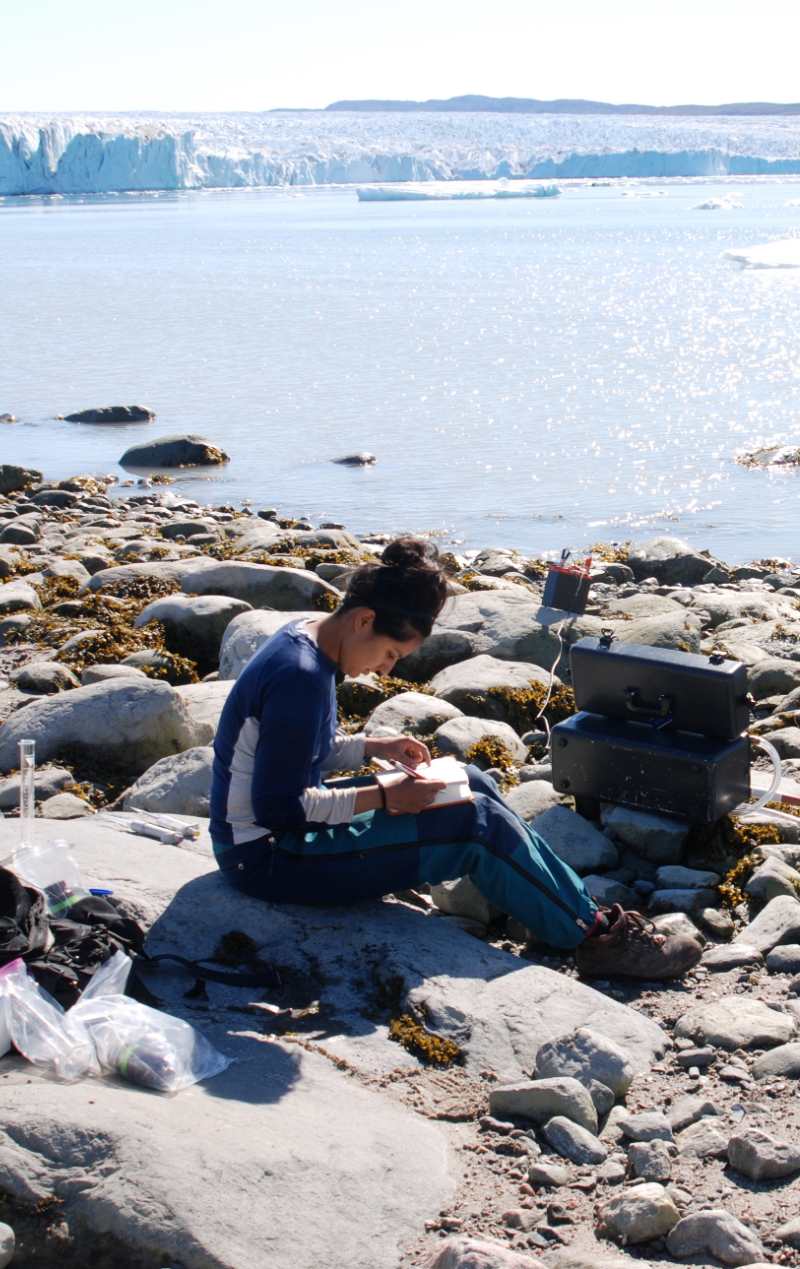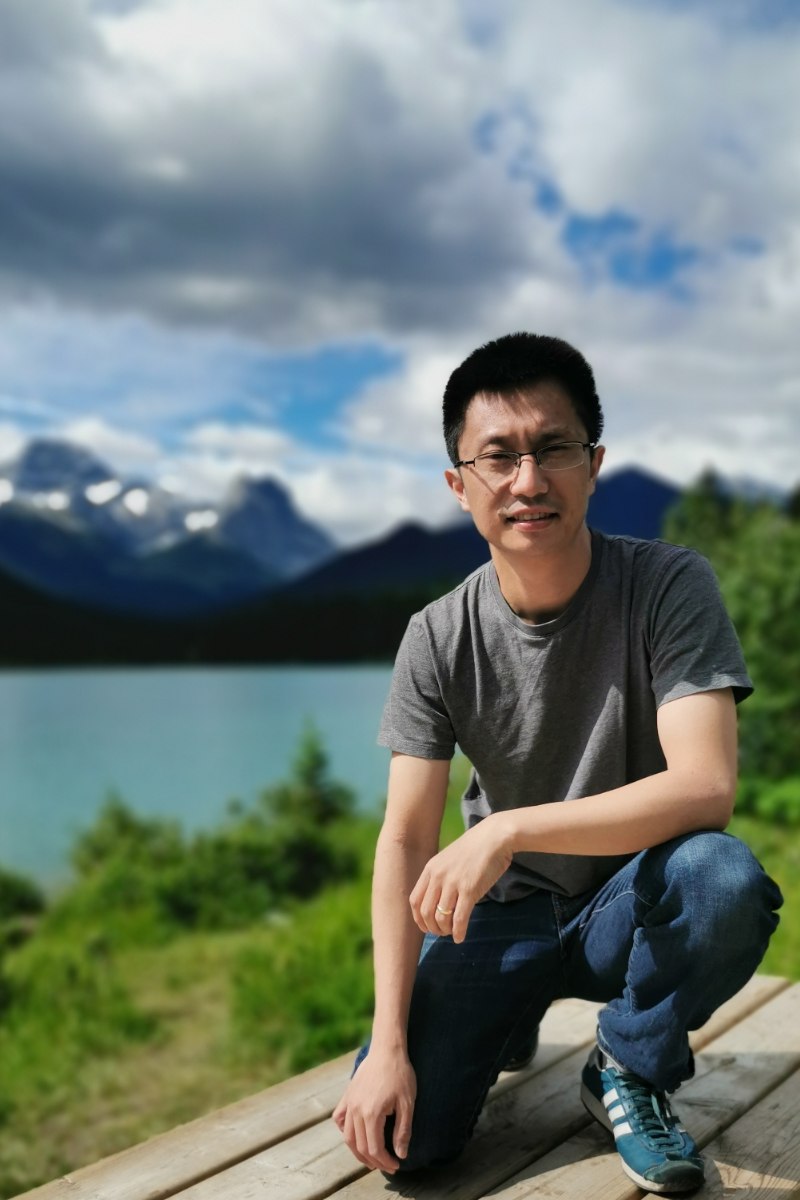
Maya Bhatia, assistant professor in the Department of Earth and Atmospheric Sciences and CAIP chair in watershed science, pictured here conducting arctic field work, received funding for her research in understanding the relationship between carbon and microbes in the Canadian Arctic.
Two researchers in the University of Alberta's Faculty of Science were awarded new funding today through a Canada Foundation for Innovation initiative, the John R. Evans Leaders Fund (JELF). JELF support is designed to provide up-and-coming scientists with the infrastructure needed to continue their work at the forefront of their respective fields.
Maya Bhatia, assistant professor in the Department of Earth and Atmospheric Sciences and CAIP chair in watershed science, received funding for her research in understanding the relationship between carbon and microbes in the Canadian Arctic. Ran Zhao, assistant professor in the Department of Chemistry, will continue to pursue his research on atmospheric and environmental pollution, including real-time chemical analysis.
Learn more about the Faculty of Science researchers and their projects below.
Meet Maya Bhatia: Arctic insights from microbial life
What is the focus of your research?
My research program sits at the intersection of biology and chemistry, focusing on how microbes interact with their environment, how they cycle carbon, and how they produce and release nutrients, and what all of this means for downstream marine ecosystems. Our work is motivated by the need to understand the impact of melting glaciers, ice caps, and ice sheets on global biogeochemical cycles.
In my lab, we use an interdisciplinary approach to explore the cycling and export of carbon and nutrients in climatically sensitive watersheds, such as in the Canadian Arctic Archipelago. As carbon is exchanged between different air, land, and sea reservoirs, it is microorganisms that inevitably control fluxes to and from various carbon pools, thus dictating the reactivity of different reservoirs. Scaled over a landscape or an ocean, microbial communities therefore represent an enormous reservoir of biological diversity and metabolic power integral to global nutrient and climate balance.
Specifically, I will focus on Arctic ecosystems. Glaciers are now recognized as microbially-based ecosystems. Understanding glacially-derived nutrients and carbon in the marine environment is imperative if we are to provide critical insight into how Arctic coastal productivity will be impacted by future climate warming.
What type of infrastructure will this new funding support?
With this funding, we will expand our infrastructure in three key areas: laboratory equipment, field equipment, and computing hardware.
New laboratory equipment will allow us to analyze water quality from glacial runoff and marine systems as well as conduct molecular-level investigations into the microbial communities' facilitation of carbon transformations between different air, land, and sea reservoirs in climatically-sensitive watersheds. Additional field equipment will include a range of vital pieces of equipment that are necessary for me and my team to independently and efficiently collect and store valuable samples from remote Arctic and alpine field sites. This equipment will also us to collect in situ measurements in the ocean, sample marine systems cleanly, and store our collected samples. Finally, it will support a new desktop computer with the powerful processing and memory system required for processing the large datasets that come from molecular meta-omic datasets.
How will these new tools support your work in pushing the boundaries of your field?
These new tools will support my work in pushing boundaries in my field by allowing us to take a more holistic view regarding the impact of melting glaciers on downstream ecosystems. Glaciation is a transformative Earth surface process. When glaciers retreat, they contribute significant quantities of water and ice, as well as sediment and dissolved chemicals to the ocean. Today, glaciers are melting at an alarming, increasing rate. The contributions of melting glaciers to sea level rise are undisputed. Yet, their contribution of materials to the oceans is only beginning to be revealed.
The new infrastructure provided by this CFI award will allow my group to quantify the modern-day export of nutrients and carbon from glacial systems, and the associated impact of this export on downstream marine processes and ecosystems, using a holistic approach that combines bulk- and molecular-level tools that bridge microbial ecology, organic geochemistry, and marine biogeochemistry. I will do this work in the Canadian Arctic Archipelago, where glacial meltwater runoff has the potential to significantly impact Northern Canadian communities as well as large-scale Arctic ocean functioning. This is a critical step towards understanding the implications of such processes on the broader ocean carbon cycle in the past, present, and future.
Why is this type of funding important?
This type of funding is important because it allows researchers to make the equipment and infrastructure purchases that are essential to building a successful laboratory and research program. This equipment will allow me to push boundaries in my field, as well as attract and produce highly-qualified personnel.
Meet Ran Zhao: Understanding air pollution in real time
What is the focuMy team is studying air pollution, which includes pollutants arising from both human-made and natural processes. One particular interest of my research team is air pollution arising from fire and combustion. From a local, Edmonton perspective, wildfires are an increasing environmental concern for our neighborhood. On the global landscape, solid fuel such as wood, coal, agricultural residual, and animal dung cake, is a major source of energy in developing countries and serves as a dominant source of air pollution in those countries.
What type of equipment will this new funding allow you to obtain?
This CFI-JELF will support infrastructure to build a cutting-edge laboratory in the field of environmental and atmospheric chemistry. I have proposed a few pieces of equipment together as a package. Together, these pieces constitute a novel setup to answer the following scientific questions.
First, what are the chemicals in air pollutants that cause adverse health effects to humans? Second, can we measure those chemicals directly from the air, as opposed to conventional methods, which requires sampling, extraction, and analysis? And finally, how do these chemicals evolve through chemistry as they spend time in the atmosphere-what is the chemistry leading to the formation of new pollutants and consumption of existing pollutants?
The core piece of equipment will be a linear-ion trap mass spectrometer with a variety of ionization sources to accommodate detection of a variety of chemical compounds.
This mass spectrometer will be coupled to two additional pieces: a particle-into-liquid sampler to achieve real-time air sampling; and a photochemical reactor to simulate atmospheric chemistry also in real time.
How will these new tools support your work in pushing the boundaries of your field?
In my research field-atmospheric chemistry-the advancement of science is driven by the development of new instruments and new detection methods.
Over the past decade, real-time chemical analysis of air pollutants has become the new standard over the conventional sampling, extraction, and analysis. This is because real-time measurements avoid excessive sample handling and minimize the chance of contamination. Real-time measurements have lead to a number of ground-breaking discoveries in my field in the past decade.
Another strength of the infrastructure lies in its flexibility in customization. My team will be able to make adjustments to achieve unique detection tailored to the air pollutants in which we are interested. Such novel detection methods often lead to the discovery of new chemical pollutants or unrecognized reaction mechanisms.
Why is this type of funding important?
There are limited opportunities for early career researchers like me to purchase a cutting-edge instrument like this one. A lack of advanced infrastructure significantly restricts the level and complexity of science questions we can possibly engage in. By offering the funding, what CFI-JELF is really offering is a career boost for early career researchers like me, by offering an opportunity for us to join the advanced scientific cohort early on.
